With seven dance companies being represented at this year’s Utah Arts Festival, the range of movement styles, techniques and languages is comprehensive. The Round stage next to the City Library will be the performing site for a crowd favorite, 1520 Arts, which specializes in hip hop, break dancing and other styles, as well as a newcomer from the festival’s Emerging Artists program, Salt Lake Dance and Parkour.
Salt Lake Dance and Parkour, June 23, The Round, 2:45 p.m.
What is Parkour? As Noriko Bell explained in 2019 at the time that the Repertory Dance Theatre offered its first beginner’s class in parkour, it was originally known as Art du Deplacement (art of displacement). The nine-man group Yamakasi (a Lingala word loosely translated in meaning as “strong man, strong spirit”) established parkour in France approximately 40 years ago. Bell explained at the time, “I firmly believe that parkour is a movement art form just as much as a physical training. Everything that you learn from parkour can be applied in the dance studio and vice versa.”
Now, Salt Lake City has its first ensemble dedicated to dance and parkour and festival visitors will see the performers — Nikita Rabbitt, Ian Chapline, Julianna Van Hook and Sean De Oliveira — perform a new piece called Sixes. Rabbitt also composed the score for Sixes, which she says is based on the musical style found in many parkour videos during the early 2000s.
The group’s members answered several questions via email from The Utah Review about their interest in parkour and its use as artistic movement. Their answers are presented here in their original form, except for minor stylistic edits, because they offer good insight in the group’s artistic mission.
TUR: How did members become interested in parkour and what are the dance backgrounds of members?
Julianna: I have been dancing for about 16 years but only got involved with parkour this year when I was introduced to the group through a dance performance at the University of Utah.
Ian: It was my passion for martial arts that led me to parkour. I began formal training in the late 2000s, and in the years since I’ve had the honor and good fortune to train with Laurent Piemontesi (a founder of the discipline), and to train and teach with a number of groups including Renaissance Movement, ParkourUtah, Flux Parkour, Wasatch Parkour, and—currently—with Salt Lake Dance and Parkour. Less extensive is my background in dance, which remains mostly non-formal.
Sean: I became interested after a friend-of-a-friend introduced me to it in 2012. The physicality and personal journey of the practice really appealed to me. I have no formal training as a dancer, but have performed in a handful of small pieces in a primarily parkour role.
Nikita: I have been dancing my whole life and am in my last semester studying for my BFA in Modern Dance from the University of Utah. I became interested in parkour three years ago after taking a community class. One of the instructors learned I was studying dance and invited me to train with a group she was putting together. The rest is history. At the time I thought it was strange how quickly everyone welcomed me, a stranger, into the parkour community, but since then I’ve actually invited several beginners to join myself. It’s just the way the community is, so welcoming and excited about anyone who shows genuine interest.
TUR: How has parkour facilitated performers in terms of their physical and mental strengths and opportunities and in ways to stretch or expand beyond previously perceived limits?
Julianna: In my limited experience with parkour, I’ve grown to understand the importance of overcoming mental barriers before one can conquer physical obstacles. While outside viewers may witness practitioners performing stunning feats of physical strength and agility, many people don’t fully understand that such things are only possible when coupled with great mental fortitude and trust in oneself. Each member of this group inspires me to continually challenge myself both physically and mentally, and through their support I have been able to do things I never thought possible.
Ian: Parkour training has drastically altered my perceptions of what is possible. So many of our own limitations are self-imposed, and we don’t see how easy they are to overcome with a little effort and persistence. That knowledge, for me, is more valuable than any amount of physical strength gained from parkour.
Sean: The most concise way to answer this question is to say that my practice of parkour demonstrated to me that I always have a little bit more to give. Always. Even if it isn’t very much. Learning that was pretty instrumental for me; It’s one of the foundational realizations that allowed me to feel certain about adopting lifelong exercise habits and going back to school. It also makes me confident that I have the capacity to learn, and get good at, anything I choose. It is an empowering feeling.
Nikita: Parkour has really strengthened my dance vocabulary. I’m now much more aware of how to shift my weight. I think parkour is a really untapped resource for dancers, because I’ve seen so many ballet-trained dancers who don’t understand the way their weight moves, so they tend to wobble and grip within large movements. Parkour has really made my movement feel much more stable and free.
TUR: Many people perceive parkour as a means of physical training but it also is a platform for a dance movement language and vocabulary on par with other forms of modern and contemporary dance. Your thoughts and insights on this would be much appreciated.
Ian: Despite various fundamental differences, both dance and parkour may be used as forms of expression—as ways of transmitting ideas through movement (both through the movement itself and through the physical space in which that movement is framed)—and, depending on who you ask, as vehicles for self-actualization and the development of community. As subjective disciplines the extent to which parkour and dance overlap ultimately depends on how the individual looking at either sees each discipline individually. My own view is that there is a 1% overlap between parkour and dance, and that that overlap contains a small but wonderful space for exploring unique movements and perspectives.
Sean: Obvious. No insight necessary, I feel. If I were to try, however, I would remark on how, from time to time, I hear people sort of equate parkour in its entirety to discrete movements or some kind of specific style. I think this (among other, shittier assumptions) might be a limiting factor in what people believe can be accomplished with parkour.
Nikita: I think as parkour becomes adopted by “bro culture,” the original spirit of parkour, involving flow of movement through the urban environment, can become lost in translation. Any movement style can be used as a platform for both artistic expression and research, so it’s not the movement itself but the way you use it. You could spend an entire dance class practicing fouette turns and calypso leaps, but learning these dance movements is not the same as learning how to dance. The same is true with parkour.
TUR: In Salt Lake City, what locations or destinations does the group especially enjoy in rehearsing and setting movement?
Group: Part of the appeal of our discipline is that you can do it anywhere. Some favorite spots of the group include the horse shoe courts at Liberty Park, and the area of the U of U campus surrounding the West-facing entrance to the Marriott Library.
1520 ARTS: The Round, June 23, 6-7 p.m.; June 24 and June 25, 6-8 p.m.; June 26, 7-9 p.m.
1520 Arts will be making its 11th consecutive appearance at the Utah Arts Festival and Joshua Perkins, chief executive and director, couldn’t be happier that the organization is back to its regular four-day schedule as one of the major anchors of the programming at The Round.
Avid fans of hip hop history know the significance of the 1520 name as the acknowledged birthplace of hip-hop: 1520 Sedgwick Avenue in the Morris Heights neighborhood of the Bronx. Before the pandemic, the organization, formerly known as The Bboy Federation, adopted its current name to emphasize its mission as preserving the core of hip hop’s cultural influence in dance, music and the visual arts and how that has expanded in other forms of cultural expression including lowrider and skateboard.
Critical to that mission is The HERC, a facility located at the organization’s South Salt Lake home, which serves more than 7,000 people annually as a hip hop arts and educational resource. The name comes from DJ KOOL HERC, considered the father of hip hop. Perkins say that performances at UAF along with their annual show at the Rose Wagner Center for Performing Arts means that the organization is serving more than 15,000 individuals who have some form of interest in hip hop culture, art, dance and music.
To wit: the festival battles and performances during the UAF will feature several generations of hip hop dancers, DJs and artists, with 12-and-under, 16-and-under, and adult groups. Some of the 1520 artists are well into their thirties and even into their forties. In essence, the stewards of Utah’s hip hop culture are ensuring that its history in their community always will be remembered. This is reflected in the annual show, They Reminisce, which will be held Sept. 16-17 at the Rose. Perkins says the show will have three story lines signifying each of the three principal eras in the development of hip hop history and culture.
As for the festival, 1520 Arts will open with its “first day back in the classroom” introduction to their art form, as it has in previous years. The hourlong workshop is meant to orient the crowd with demonstrations and information, which would be similar to going to THe HERC. Perkins says it is a quick-paced primer about the general history while demonstrating as many elements as possible. Kids particularly enjoy watching the demonstrations of dance movement, the art of DJing and the gear typically involved in a show.
On Friday, the heat is turned up with the youngest performers in a 2 v. 2 breaking battle, featuring participants from Salt Lake and Utah counties. Saturday features eight crews of two dancers each in the adult 2 v. 2 battle. Sunday, the competition becomes a 3 v. 3 open style battle. What adds to the spontaneity of the battles is that the teams are put together randomly so that they have to use their instinct to sync up and collaborate if they want the bragging rights of winning. “This makes it difficult to predict how a battle will go,” Perkins says, “as here the crews will have to perform outside of their normal grouping.”
With two hours on each day, with the exception of Thursday, Perkins says there will be time for other performances besides the battles — notably, the cypher. As explained previously in The Utah Review, the art of cypher emphasizes the objective of community equality in hip-hop, as echoed in the origins of the word, which came from the Arabic term of sifr that represents zero. Cyphers have always been integral to hip-hop culture and where its earliest performers gathered to share creative ideas and challenge them accordingly. Cyphers are entertaining and intense but they also serve the critical function of unity that respects and protects a diverse community. They augment the good-natured senses of the dance battles.
DJ SkratchMo (Gabriel Ghent) returns as a headliner along with other artists including DJ Nick at Nite. Perkins also will throw down his skills, with his performing persona DJ Text.

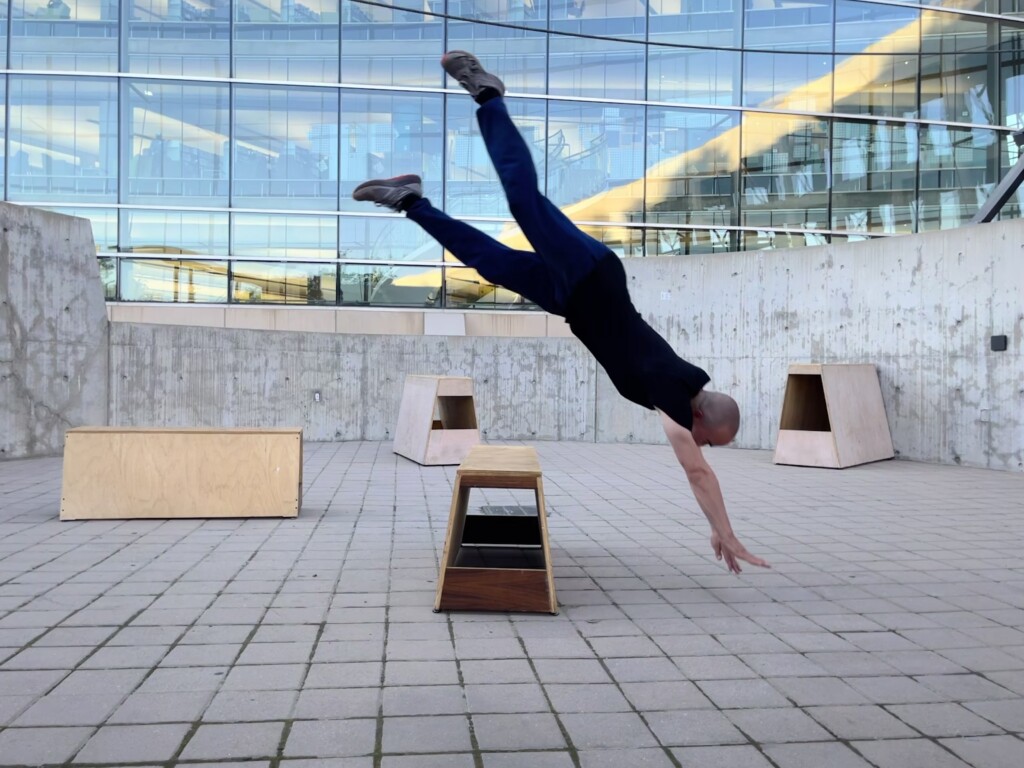

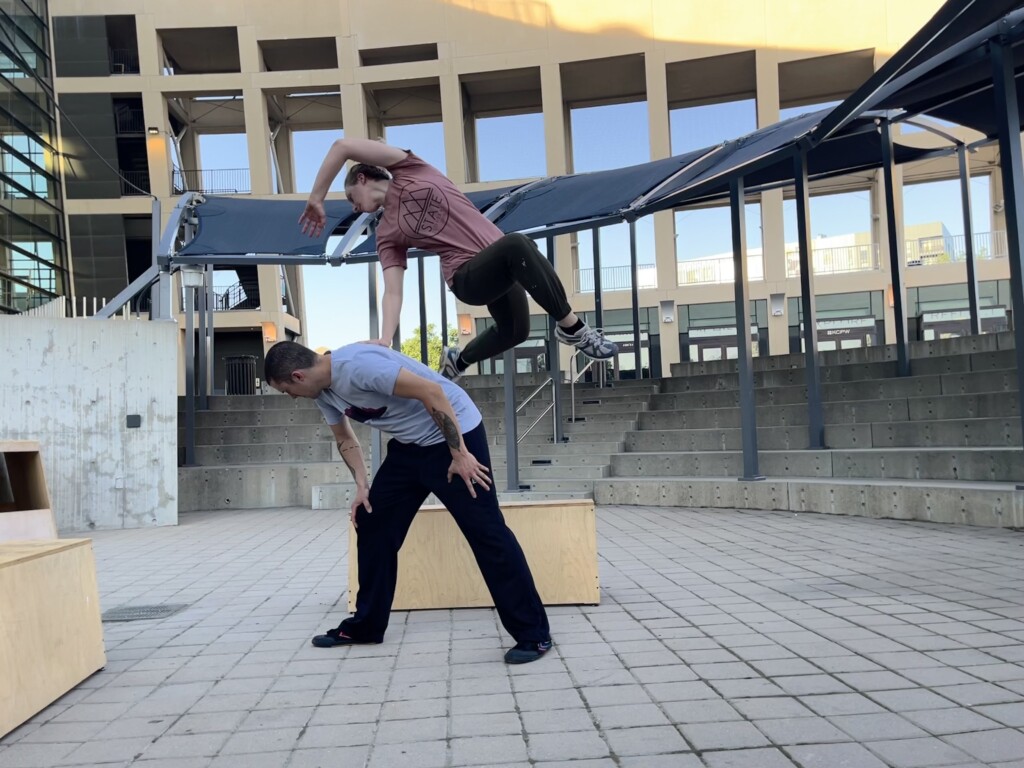
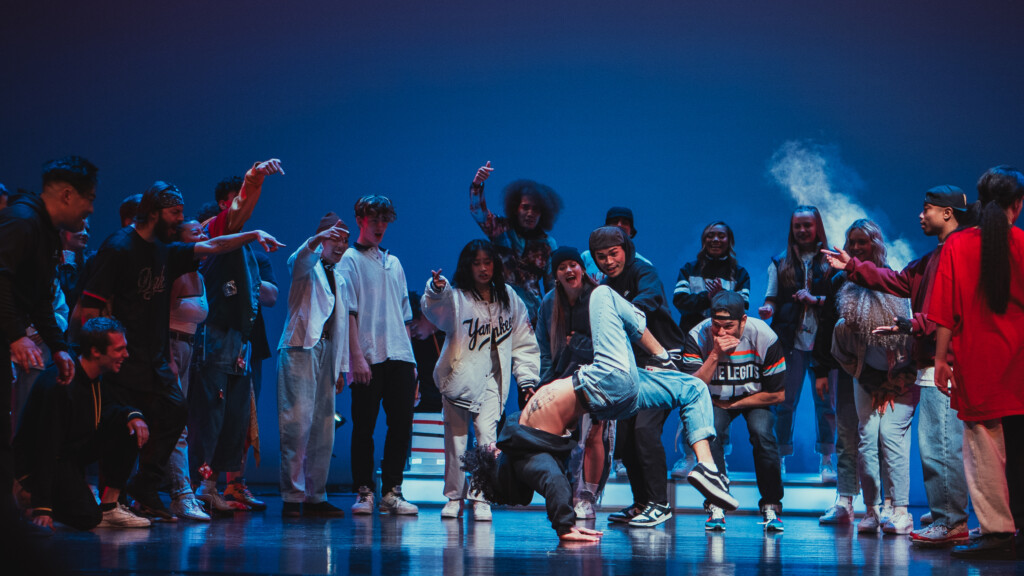
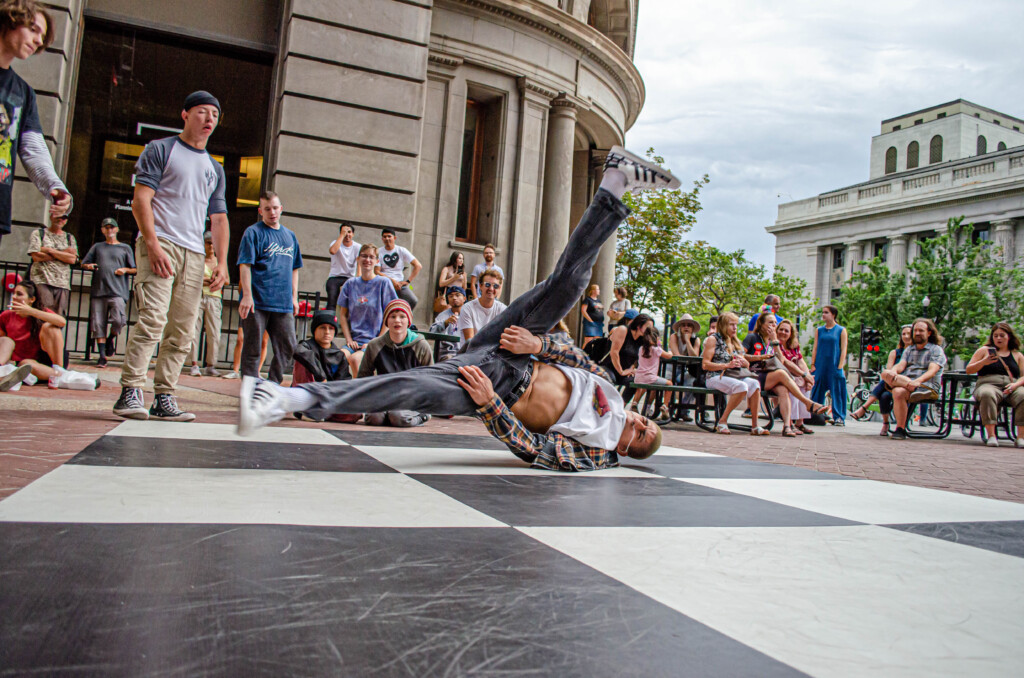
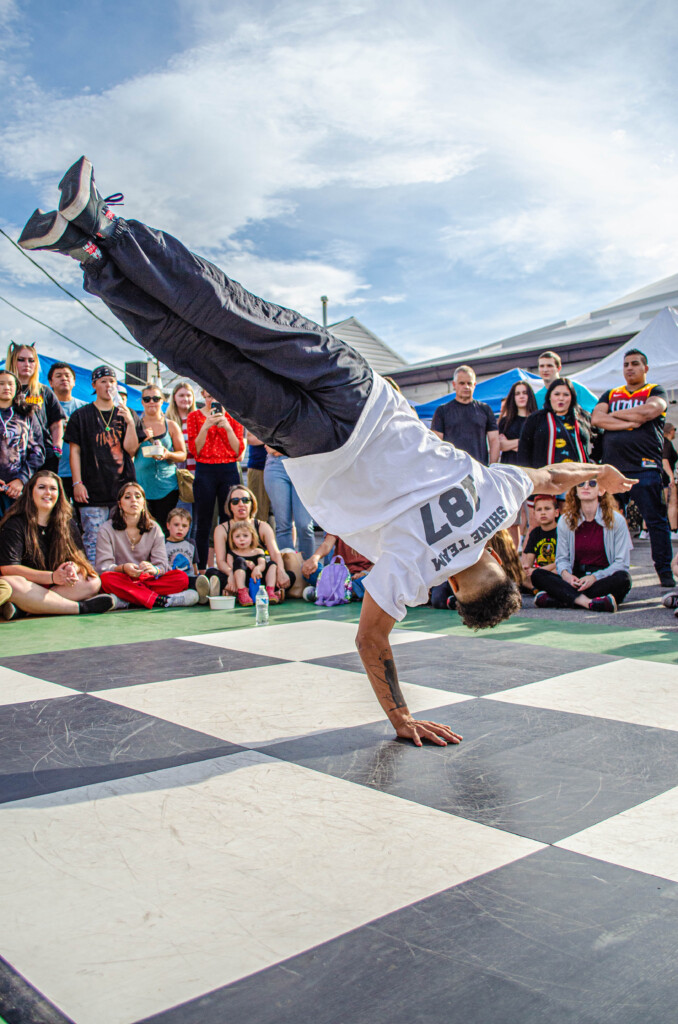
1 thought on “Backstage at the Utah Arts Festival 2022: The Round stage welcomes perennial favorite 1520 Arts and Emerging Artists newcomer Salt Lake Dance and Parkour”